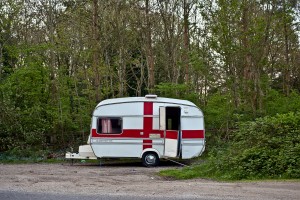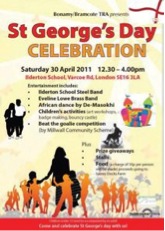 Mid-April, and approaching another St. George’s Day. Last year, at approximately this time, we were getting ready for the first leg of the EUMIA fieldwork, focussing on the St. George’s Day celebration in Bermondsey, South London. In this blog, I will discuss the significance of this celebration as both a successful, locally led community event and an inclusive coming together around something that is, essentially, very English (though St George is actually, as many local residents and stakeholders told us, the patron saint of not just England, but a wide range of countries and cities around the world).
Mid-April, and approaching another St. George’s Day. Last year, at approximately this time, we were getting ready for the first leg of the EUMIA fieldwork, focussing on the St. George’s Day celebration in Bermondsey, South London. In this blog, I will discuss the significance of this celebration as both a successful, locally led community event and an inclusive coming together around something that is, essentially, very English (though St George is actually, as many local residents and stakeholders told us, the patron saint of not just England, but a wide range of countries and cities around the world).
Capturing the flag
In comparison to, for example, Scandinavian countries where use of the national flag is associated with any kind happy event, the English flag is used with much more restraint. Apart from sports events – typically football tournaments where myriads of St George’s flag emerge, only to disappear again after another lost penalty shoot-out – the English flag has been out of favour in the public sphere, ‘successfully’ captured by far-right political parties and therefore often widely frowned upon by ‘polite society’.
Bermondsey would seem an example of such a ‘capture’. A white working-class inner city area, Bermondsey was targeted by the British Fascist Party in the 1930s. Later, in the 1980s and 1990s, a widespread perception of the neighbourhood as racist, insular and hostile to outsiders was underpinned by a longstanding association between Bermondsey and the British National Party (BNP), with BNP staging marches through Bermondsey on St. George’s Day.
While such perceptions still exist, the demographic profile of Bermondsey has changed dramatically over the past years. In South Bermondsey, where the St. George’s Day celebrations take place, the White-British proportion of the population declined from approx. 60% in 2001 to 40% in 2011. Though nearly 30% of the minority ethnic population in South Bermondsey in 2008 still considered racial harassment a serious problem (CLG, 2008), the last decade has nevertheless seen a co-incidence of declining levels of racial harassment (as experienceded by local residents) and an increasing proportion of non-white residents.
Standing up for the area
The St George’s Day celebration emerged against a backdrop where local authorities were looking for ways to counter racism in Bermondsey. A hate-crime conference had failed spectacularly, as recalled by Darryll Telles, Neighbourhood Engagement Manager in Southwark:
‘Of course the issue there is that if you call something hate-crime, then people feel scared to come forward. But also, people do not want to be associated with something that actually, how can I put it, denigrates the area. And that was a real learning curve for me, and the board [...] actually, we’ve got to start standing up for the area.’
This notion of standing up for the local area was also expressed by Pat Hickson, chair of the Bonamy Estate, and the prime mover who got the event of the ground. She felt that whereas events were put on throughout Southwark Borough to celebrate diversity – for example St. Patrick’s Day for the Irish minority, Bermondsey Carnival and the Black History Month (celebrated borough-wide) – the White-British population was, she felt, being left out, forgotten. Accordingly, a celebration of St. George’s Day provided an appropriate occasion that could bring together the local community around a celebration of something essentially English.
Other residents would agree, but also emphasize the active re-claiming of the flag – as observed by a long-term resident and community activist:
‘I think it is quite interesting, because there is a sense that people want to reclaim the cross of St George as something we can be proud of. Being English, and not being racist in that’.
Staging the event
 First staged in 2006, the festival takes place every year on a Saturday afternoon in late April. It has throughout the years been staged at the grounds of the local Ilderton Primary School, with 400-500 participating residents, largely from surrounding estates. There is also a range of local stall-holders. At the 2013 event, these included a gardening programme set up by one of the TRAs, selling plants, and stalls selling knitted, heart-shaped St. George’s flags. Surrey Docks Farm, a local pet farm, showed off some of their smaller animals, and the efforts of the face painters would show in the faces of many of the kids on the venue. Bands from two local schools were playing, one of them a steel band. Millwall was staging a ‘beat the goalie’ tournament in a separate part of the school yard, and a number of local businesses had contributed vouchers to the raffle that concluded the afternoon.
First staged in 2006, the festival takes place every year on a Saturday afternoon in late April. It has throughout the years been staged at the grounds of the local Ilderton Primary School, with 400-500 participating residents, largely from surrounding estates. There is also a range of local stall-holders. At the 2013 event, these included a gardening programme set up by one of the TRAs, selling plants, and stalls selling knitted, heart-shaped St. George’s flags. Surrey Docks Farm, a local pet farm, showed off some of their smaller animals, and the efforts of the face painters would show in the faces of many of the kids on the venue. Bands from two local schools were playing, one of them a steel band. Millwall was staging a ‘beat the goalie’ tournament in a separate part of the school yard, and a number of local businesses had contributed vouchers to the raffle that concluded the afternoon.
Was that a march?
There was among research participants a wide-spread recognition that the St George’s Day celebration has grown into an increasingly inclusive event where the people mix by and large would reflect the demographics of the area – i.e. middle-aged and elderly white residents, and BME youths and families.
And the BNP marches? A local, black librarian remembered how, in the 1990s, he and other black colleagues would be asked to go and work in libraries in other parts of the borough when a march was announced. This constitutes a stark contrast to the present situation:
‘I think there was a march, was it a year or two ago? [...] What happened is that you maybe had half a dozen or a dozen people just walking along the street [...] In fact, I didn’t actually realise there was a march, and it wasn’t until I looked that I thought “oh, this is supposed to be a march”.
References
- Communities and Local Government (CLG) (2008) Community cohesion and neighbourhood management: A theme report from the neighbourhood management pathfinders national evaluation. Department of Communities and Local Government.